Table of Contents
1. Introduction
Compressors are the mechanical means to increase vapor pressure, as pumps are used to increase liquid pressure .
There are two basic types of compressors, reciprocating and centrifugal. Each has one specific duty to intake vapor at low pressure, compress it and discharge it at a higher pressure. The quantity of vapor to be moved and discharge pressure it usually the deciding factor in the type selected .
1.1 Reciprocating compressors
Reciprocating compression is the force converted to pressure by the movement of the piston in a cylinder. These machine are generally specified for lower volumes than centrifugal compressors. If several stages of compression are employed, extremely high pressures may be developed. Because of their reciprocating action these machines cause piping, if not properly designed and supported, to pulsate, vibrate and generate fatigue .
1.2 Centrifugal Compressors
Centrifugal compression is the force converted to pressure when a gas is ejected by an impeller at increasing velocity. Centrifugal compressors are specified for large quantities of vapor. Pressure differential may be small or large. These machines are not subject to pulsation and therefore do not produce vibrational effects .
1.3 Compressor Drives
Drivers fall into three categories, i.e. electric, steam and gas.
Electrical drivers range from small flameproof motors to large motors, 2000 HP or more, requiring their own cooling systems . Steam drivers are comprised of single or multistage turbines, either fully condensing of backpressure . Gas drivers cover gas turbines or gas engines.
2. Reciprocating Compressors
2.1 Types of Machines
Reciprocating compressors can be obtained in a variety of patterns from a simple single cylinder to multicylinder multistage machines. See figure 1,2,3 for the most widely used patterns.
Figure 1 below is a single cylinder machine. It will operate at low speed, may be single or double acting.
Figure 2 is a balanced horizontally opposed multicylinder machine. It will operate at low speed, may be single or double acting, it can also be multistage .
Figure 3 is a gas fuelled angle - type engine. The compression cylinders are all on one side of the frame, cylinder diameters and lengths vary according to the composition, pressure and volume of gas to be compressed. Dimensions from frame center line to cylinder nozzles will vary with compression forces.
2.2 Types of Cylinders
Figure 3. Gas engine driven machine (note: gas engine may take 'V' form)
Figures 4,5 for details of cylinder arrangements.
Figure 4: single acting cylinder, having one suction, compression and discharge area per cylinder.
Figure 5 : double acting cylinder, having two suction, compression and discharge areas per cylinder.
Multicompression stages : number of times the vapor is compressed by going through a series of compression cylinders to increase pressure.
Gas compression raises temperature. In a reciprocating machine, compression is violent and heat rise is great. Inlet temperatures of 40 oC may be raised to over 100 oC by the act of compression. The cylinder gets hot and depending on the vapor being compressed, will need some form of cooling. This will usually be in the form of cooling water, but for low heat increases a glycol - filled jacket may suffice .
2.3 Compressor Foundation, Cylinder and Snubber Supports
The foundation for LP reciprocating compressors must be independent from all other foundations. It must support the compressor and all its auxiliary equipment.
Cylinder supports are supplied by the vendor if they are required.
They must be attached to the foundation concrete. Likewise the snubber supports must be attached to the foundation concrete, springs will be used locally to support the snubbers .
2.4 Compressor Layout
Effective compressor layout results in cost savings on process and utility piping, good maintenance accessibility and possibly reduced pulsation in suction and discharge piping. Poor layout does the opossite.
See below figure; TYPICAL LAYOUT OF COMPRESSOR HOUSE & SUCTION KNOCK OUT DRUM
For angle type compressors, locate the crankshaft parallel to the suction and discharge headers. For balanced horizontally opposed compressors, the crankshaft should run at right angles to the suction and discharge headers. Compressor houses containing more than one machine, particularly if they are long, will probably be equipped with a travelling gantry crane which will be manually or electrically operated. This feature can influence the overall dimensions of the house, as in addition to the necessary building and maintenance clearances, the vertical reactions of the loaded crane will increase foundation size. Since these must not be connected to the machine foundations, the building size will be affected. It is usual for compressor vendors to indicate the overall foundation dimensions on their layout drawings. (These should be requested as early as possible).
The compressor building must be sized very early in the layout stage when only preliminary dimensions are available. It may be known that the overall length of the machine is 6 meters and the width is 4 meters. To these dimensions must be added adequate clearance for maintenance plus possible control valve stations, lube oil equipment, local control panel, etc. Allow 2 meters all around the original dimensions. In practice this 2 meter allowance will provide a walkway of only 1200 - 1500 mm due to other items occupying floor space. With two or more machines, allow 2 meters between compression cylinders to allow for adequate piston removal. All dimensions must be confirmed from certified vendor drawings.
Allow a maintenance area at one end of the building. A 6 meter bay should be sufficient . Pits, trenches and similar gas traps should be avoided in gas compressor houses . Large reciprocating gas compressors will usually be elevated abovegrade with mezzanine floor level with the top of the foundation for operation and maintenance. The height of the mezzanine floor abovegrade will be kept to a minimum consistent with the adequacy of space for piping and access, especially to valves and drains .
2.5 Piping Layout
The piping layout will follow the plow diagrams as issued for the job. If they conflict with any of the following notes, the flow diagrams will always take precedence. It is usual for the suction piping to be routed to the top of the cylinder and discharge piping from the bottom. Liquids must be prevented from entering the compressors. As liquids do not compress, extensive precautions must be taken to ensure that absolutely no liquid enters the compressor cylinder ; a small quantity would do extensive damage.
If there is any doubt that the vapor is near its dew point, the suction line must be steam traced between the suction drum and the compressor inlet or local to the compressor inlet. Process Department will advise the extent and it will be shown on the flow diagram.
Suction and discharge headers will be located at grade level on sleepers up to the first piece of connecting equipment, e.g. suction KO drum or aftercooler. Branch connections to the compressor from the suction header will be taken from the top of the header . Suction and discharge piping will be kept as straight as possible between the compressors and headers. The use of short radius bends or tees and similar installations giving opposed flow shall not be permitted .
Piping shall not be less than compressor nozzle size. Piping local to cylinders shall clear the cylinder by sufficient distance to permit proper maintenance on the cylinder valves. When compressors are elevated with a mezzanine floor, piping and valves will normally run under the floor.
When more than one compressor is employed on the same service, all piping to and from the compressors will be valved so that any compressor may be shutdown and taken out of service. Spectacle blindes will be installed at the compressor side of the isolating valves.
Startup bypasses are to be installed between suction and discharge pipes of compressors and will be located between the compressor and the line block valve. When not furnished by the manufacturer, a relief valve will take be installed between the compressor discharge and block valve. This relief valve will discharge into the suction line downstream of the block valve. The relief valve will be provided with a bypass for hand venting.
Distance piece and packing vent piping will be manifolded into systems as indicated on the flow diagrams. These systems are either vented to atmosphere outside the compressor house or connected to a collection system.
Utility piping will comprise cooling water supply and return to lube oil cooler also to cylinder jackets. The minimum line size used will be 3/4” . Sufficient vents and drains will be provided so that water lines and jackets may be completely drained at shutdown. A steam or electrical supply may be required if lube oil heaters are provided for either the compressor or gear box oil. This system is used prior to startup.
Check for lines that have to be chemically and ensure drawings indicate this requirement .
3. Centrifugal Compressors
3.1 Types of Machine
Centrifugal compressors can be obtained in a variety of patterns. See figure 8. Centrifugal Radial Compressor
Centrifugal radial compressors ( figure 8) : the compression process is effected by rotating impellers of radial flow design ( figure 9 Radial Impellor) in fixed guide elements.
Centrifugal axial compressors ( figure 10) : the force is converted into pressure by rotating vanes between fixed guide vanes; the flow is axial .
3.2 Size and Position of Nozzles
Centrifugal compressor manufacturers have basic case designs; they change the rotor blade design to meet volume and pressure requirements. For this reason suction nozzles are sometimes much larger or smaller than the line size for hydrocarbon process applications. For example, a 30” suction nozzle may have a 20” or 24” suction line. It will be necessary to increase the suction line diameter locally at the compressor nozzle. Do not use a reducing flange as this will introduce full velocity to the rotor blades at a turbulent condition. Use 30” flange and a concentric reducer as a minimum. It is better if a pipe length of 3 dias of 30” pipe can also be accommodated .
Suction and discharge nozzles are either on the underside or the top of the compressor. On multistage compressors two or more inlet nozzles may be provided ; the suction lines are connected to suction drums controlled to maintain the various inlet pressures .
3.3 Compressor Foundations
(See fig.10 Centrigfugal axial compressors)
The foundation of each machine will be combined with its direct coupled drives but must be independent from all other foundations, including the lube console .
3.4 Compressor Layout
(See fig. 11,12,13 below)
Centrifugal compressors are usually large capacity machines. They are driven by electric motors, steam or gas turbine, the drive may be via a gearbox. It is usual to mount such machines on a tabletop about 4 meters high with elevated access all around. The lube and seal oil consoles for both the compressor and turbine, if used, will be located at grade. The suction and discharge connections of the compressor will most likely be on the underside; these lines can be anchored at grade. Should these connections be on the top of a horizontally split case compressor, see fig 13 for details of removable spools.
A typical compressor house layout is shown in figures 11 and 12. Here an electrical motor and a condensing type turbine has been used. Note the withdrawal and maintenance areas, also the acoustic hoods. Determine the type of travelling gantry crane, and ensure that piping, etc. is clear of it. Note the lube oil header tanks, these must be elevated above the machines, if the vendor has not stated a minimum elevation use 10 meters above the center line of the machines.
Their purpose is for emergency lubrication, and are tripped - in should the normal lubrication supply system fail. They supply oil to the bearings until the machine comes to a standstill .
The lube and seal oil consoles are comprised of the following items : oil storage tank, filters, pumps, oil cooler, sometimes an oil heater for startup, control instruments.
Interconnecting piping must be in accordance with the flow diagram, all return lines must be free - draining from the machines to the console.
Suction and discharge piping must be supported so that the nozzles are not overloaded, use reducers not reducing flange local to suction and discharge nozzles. Make provision for removal of strainers in the inlet line. Silencers may be required in both the suction and discharge piping.
Acoustic hoods may be required for both the compressor and turbine ; ensure that the tabletop is large enough to accommodate them. They may be of sectional construction. The travelling gantry crane will be used to dismantle them; this must be taken into consideration when determining the elevation of the crane hook.
Maintenance area must be large enough to accommodate the acoustic hood, turbine and compressor half casing rotors, etc.
4. Drives
4.1 Electrical Motors
Flameproof motors will be employed for small to medium HP machines.
Ensure that the cables can be routed to the terminations, also that there is space behind the motor to remove the rotor .
Large HP machines their own cooling systems ; these fall into two categories : CACW (close - air - circuit water cooled machine ) or CACA ( closed - air - circuit air cooled machine ) . These types of machines may require an area of 7 m x 7 m and, therefore, determine the size of the compressor house.
CACW machines (see fig. 14) : may be mounted on a tabletop with the cooler located under, in a sealed room. The cooling air circulating around the motor is itself cooled by water cooled heat exchanger. Provision must be made for removal and service of the exchanger.
It is possible to obtain motors with the cooler mounted above or to one side of the motor.
CACA machine consideration must be given regarding the safe location of the air intake, which will be outside the compressor house. If a filter is required in the intake system, provide access for replacement or cleaning .
4.2 Steam Turbines
Two types of steam turbines must be considered, condensing and noncondensing. The noncondensing type uses high pressure steam and exhausts lower pressure steam to a stream header. The condensing turbine exhausts to a surface condenser (which is usually a large exchanger with hot well attached, but may take the form of an air fan ) to recover condensate. Surface condensers are often grade-mounted directly below the compressors turbine. This arrangement employs a turbine with outlet nozzle directly connected via an expansion joint to the surface condenser. (See fig.16 ) . The surface condenser may be mounted at grade alongside a grade-mounted turbine. With arrangement very little NPSH is available.
If an air fan is used as a surface condenser it will usually be located above the turbine, either on the compressor house roof or over a pipe rack. If the condenser is the shell and tube type, it will most likely be of the fixed tube plate design and will require access for rodding the tubes. The cooling water lines associated with the condenser are large bore and some consideration must be given to the piping arrangement and placing of valves to give good operation and utilization of plot space.
The steam supply to the turbine will be taken from the top of the steam header, a bellow may be required local to the turbine and a temporary strainer will be used for startup.
The turbine will required a similar lube oil console to that provided for the compressor. Do not pocket the return drains. An elevated lube oil header tank also be required.
Noncondensing turbine assemblies comprise a turbine, lube oil console and header tank. The low pressure steam discharge line will be a large bore, a bellow will most likely be required in the line, which must join the top of the header. If the line has a low point, a steam trap and drip pocket must be provided.
Maintenance access : provision must be made to dismantle the acoustic hood, and remove half of the turbine casing and the rotor .
4.3 Gas Turbines
When using a gas turbine to drive a compressor, a similar arrangement to a steam turbine can be used; the lube oil console and header tanks will be required. In addition, the exhaust system must be considered; this will be comprised of ducting to some heat recovery system, either a steam raising plant or process heaters.
Combustion air to the turbine burner must be taken from a safe location outside the compressor house. Inlet silencer and filter will most likely be required. Provision for operation and maintenance to all machinery must be provided .
4.4 Gas Engines
Gas engines are used to drive reciprocating compressors, either directly or through a gearbox. The machine may have both compression and drive cylinder attached to a common crankshaft. These types of engines may develop 2,000 HP or more. Ensure that adequate space is allowed for removal of cylinder heads and pistons. The lube oil system may be integral with the engine that or in the form of a console. Should the latter be used, ensure that the engine is at suitable elevation to allow for free-draining oil return lines. (see fig.17)
The engine and compressor will be mounted on a common foundation that is independent of all other foundations. Due to the vibration produced by these machines, a large mass concrete foundation will be employed.
The general layout of the compressor house will enable the use of a travelling gantry crane for all maintenance, therefore when routing piping this must be considered. It is not likely that a mezzanine floor will be employed local to the machines, enabling most of the piping to be kept low.
Combustion air must be taken from a safe location outside the compressor house. If an air filter will be required, arrange for maintenance access. Likewise, the exhaust must be discharged outside the building.
This system will be fitted with a silencer and flame trap. Utility systems will comprise a start-up air system, also fuel gas. The engine will most likely have a closed circuit jacket water cooling system.
This will comprise a shell and tube exchanger or an air fan. If the former, cooling water supply will be required and the usual clearance for tube pulling, etc. will be provided. (see fig.18).
Figures incl.
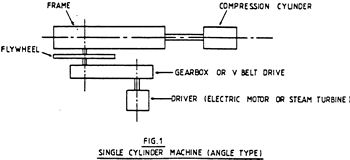
Figure 1 below is a single cylinder machine. It will operate at low speed, may be single or double acting.
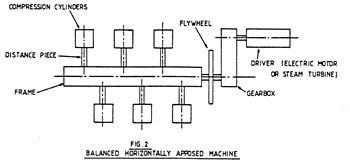
Figure 2 is a balanced horizontally opposed multicylinder machine. It will operate at low speed, may be single or double acting, it can also be multistage.

Figure 3. Gas engine driven machine (note: gas engine may take 'V' form)
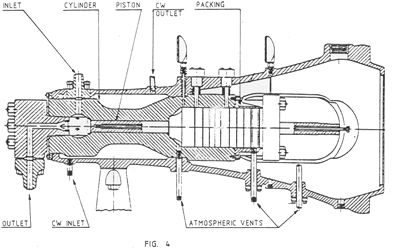
Figure 4: single acting cylinder, having one suction, compression and discharge area per cylinder.

Figure 5 : double acting cylinder, having two suction, compression and discharge areas per cylinder.

Figure 6: DETAIL OF FOUNDATION & SUPPORT FOR CYLINDER & SNUBBERS

Figure 7:TYPICAL LAYOUT OF COMPRESSOR HOUSE & SUCTION KNOCK OUT DRUM
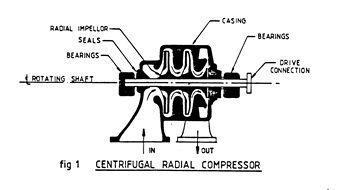
Figure 8: Centrifugal Radial Compressor
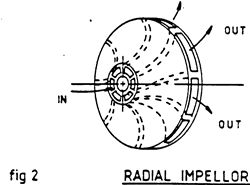
Figure 9: Radial Impellor
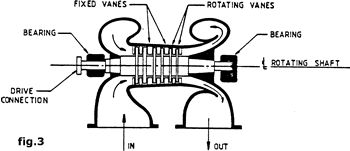
Figure 10: Centrigfugal axial compressors

FIG. 11 TYPICAL LAYOUT FOR COMPRESSORS ONE TURBINE DRIVEN ONE ELECTRIC MOTOR DRIVEN
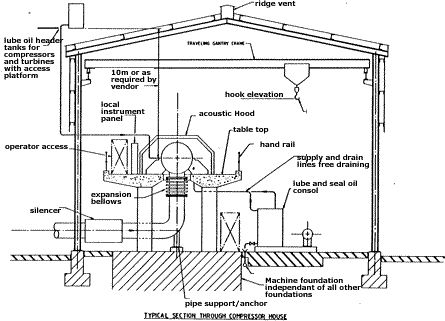
fig. 12 TYPICAL SECTION THROUGH COMPRESSOR HOUSE
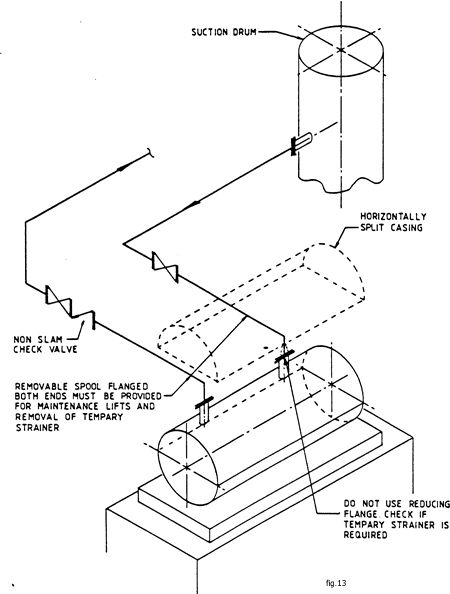
FIG.13 THE NOZZLE ORIENTATION FOR HORIZONTALLY SPLIT COMPRESSOR CASING
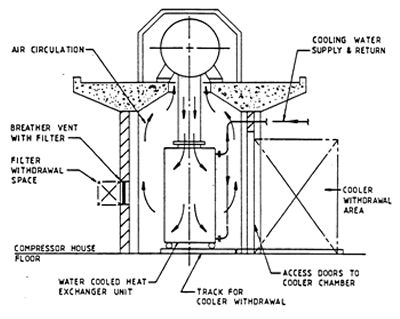
FIG.14 TYPICAL SECTION THROUGH A 'CLOSED-AIR-CIRCULATION WATER-COOLED MACHINE'

FIG. 15 TYPICAL SECTION THROUGH A 'CLOSED-AIR-CIRCULATION AIR-COOLED MACHINE' NOTE: CLOSED-AIR-CIRCUIT AIR COOLED (CACA) ENCLOSURE A TOP MOUNTED AIR TO AIR HEAT EXCHANGER IS USED. tHE EXTERNAL AIR IS CIRCULATED BY MEANS OF A SHAFT MOUNTED FAN IN THE CASE OF CAGE MACHINES AND BY SEPARATE MOTOR/FAN UNITS MOUNTED IN THE DUCTING FOR WOUND ROTOR MOTORS
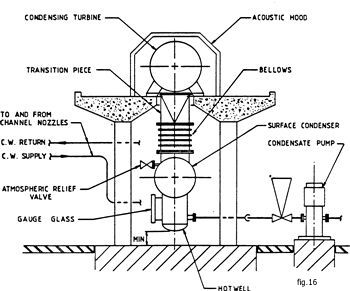
FIG.16 TYPICAL SECTION THROUGH A CONDENSING TURBINE SET
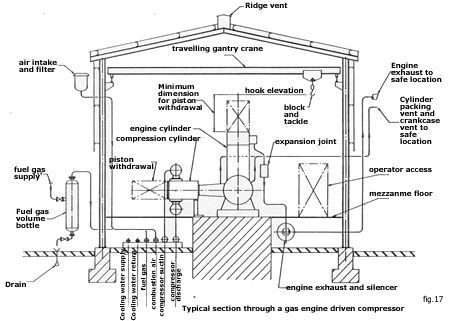
FIG. 17

FIG.18

